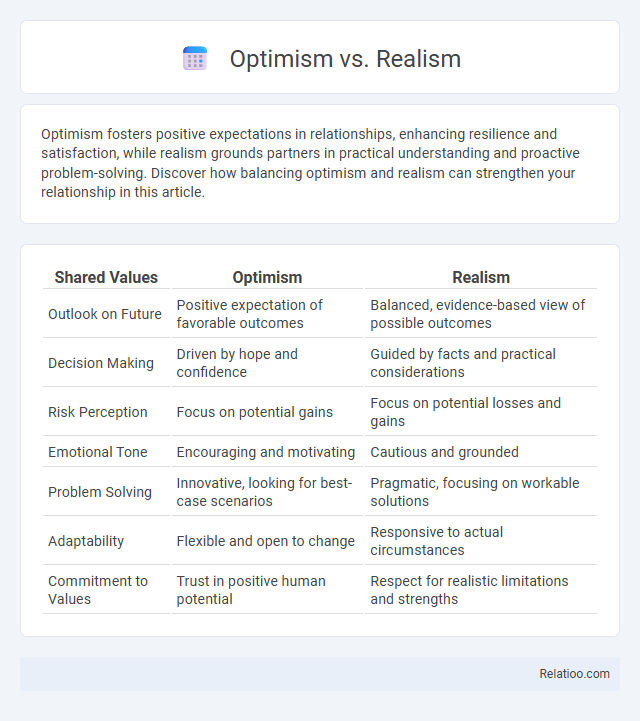Optimism fosters positive expectations in relationships, enhancing resilience and satisfaction, while realism grounds partners in practical understanding and proactive problem-solving. Discover how balancing optimism and realism can strengthen your relationship in this article.
Table of Comparison
| Shared Values | Optimism | Realism |
|---|---|---|
| Outlook on Future | Positive expectation of favorable outcomes | Balanced, evidence-based view of possible outcomes |
| Decision Making | Driven by hope and confidence | Guided by facts and practical considerations |
| Risk Perception | Focus on potential gains | Focus on potential losses and gains |
| Emotional Tone | Encouraging and motivating | Cautious and grounded |
| Problem Solving | Innovative, looking for best-case scenarios | Pragmatic, focusing on workable solutions |
| Adaptability | Flexible and open to change | Responsive to actual circumstances |
| Commitment to Values | Trust in positive human potential | Respect for realistic limitations and strengths |
Defining Optimism and Realism
Optimism is a mindset characterized by the expectation of positive outcomes and a focus on favorable possibilities, often fostering hope and motivation. Realism emphasizes a grounded perspective, acknowledging both positive and negative aspects of situations with an objective assessment based on facts and evidence. Understanding optimism and realism involves balancing hopeful anticipation with practical evaluation to navigate challenges effectively.
Key Differences Between Optimism and Realism
Optimism centers on expecting the best possible outcomes and maintaining a hopeful outlook despite challenges, while realism emphasizes accepting situations as they are based on factual evidence and practical considerations. The key difference lies in optimism's tendency to view the future through a positive lens, often anticipating success, whereas realism acknowledges potential obstacles and uncertainties without bias. This contrast affects decision-making, where optimists may pursue opportunities with confidence, and realists prepare for various scenarios by evaluating risks and benefits objectively.
The Psychological Roots of Optimism
The psychological roots of optimism stem from cognitive biases and positive expectations shaped by early life experiences and neural pathways associated with reward and motivation. Optimism involves a tendency to anticipate favorable outcomes, often supported by the brain's dopamine system, which reinforces hopeful thinking and resilience. Realism, contrastingly, grounds itself in an accurate assessment of reality, balancing optimism with pragmatic evaluation of risks and facts.
How Realism Shapes Decision-Making
Realism grounds decision-making by emphasizing objective analysis of facts and potential constraints, leading to practical and achievable goals. This approach contrasts with optimism's focus on positive outcomes and possibilities, fostering balanced strategies that mitigate risks. Realism enables leaders to anticipate challenges accurately, allocate resources effectively, and develop contingency plans for informed and resilient choices.
Benefits of Embracing Optimism
Embracing optimism enhances your mental resilience by promoting positive thinking and reducing stress levels, which improves overall well-being. This mindset fosters motivation and increases your ability to overcome challenges through hopeful expectations and proactive behavior. Optimism also strengthens social connections by encouraging empathy and collaboration, leading to a more supportive environment for growth and success.
The Strengths of a Realist Perspective
The strengths of a realist perspective lie in its grounded approach to assessing situations based on factual evidence and practical outcomes, enabling more accurate predictions and effective decision-making. Realism prioritizes objective analysis over emotional biases, which helps in managing risks and preparing for potential challenges. This pragmatic viewpoint balances idealistic goals with practical limitations, fostering resilient strategies that adapt to real-world complexities.
Potential Pitfalls of Excessive Optimism
Excessive optimism can lead to unrealistic expectations, causing individuals or organizations to underestimate risks and overlook critical challenges, which may result in poor decision-making and financial losses. Realism incorporates a balanced assessment of both opportunities and threats, fostering more accurate forecasting and strategic planning. Embracing optimism tempered by realism helps maintain motivation while ensuring preparedness for potential setbacks.
When Realism Becomes Limiting
Realism becomes limiting when it restricts your ability to envision possibilities beyond current constraints, stifling innovation and personal growth. While optimism fuels motivation and expands potential by focusing on positive outcomes, unchecked optimism may ignore risks, making a balanced perspective essential. Navigating between optimism and realism allows you to set achievable goals while maintaining hope for success.
Striking a Balance: Optimism and Realism in Everyday Life
Striking a balance between optimism and realism fosters a practical yet hopeful outlook, enabling individuals to set achievable goals while maintaining motivation. Embracing optimism encourages resilience and positive mental health, whereas realism ensures decisions are grounded in facts and potential risks. Integrating both perspectives enhances problem-solving skills and promotes adaptive strategies in everyday challenges.
Practical Tips for Cultivating Healthy Optimism and Realism
Balancing optimism and realism involves recognizing both potential opportunities and real challenges to make informed decisions. You can cultivate healthy optimism by setting achievable goals, maintaining a positive mindset grounded in facts, and preparing for possible setbacks with practical strategies. Regularly reflecting on your experiences and adjusting expectations helps maintain a realistic outlook while fostering resilience and motivation.

Infographic: Optimism vs Realism
 relatioo.com
relatioo.com